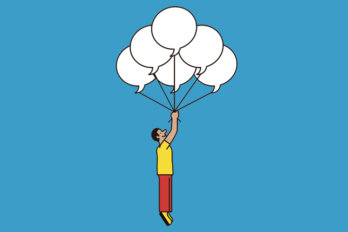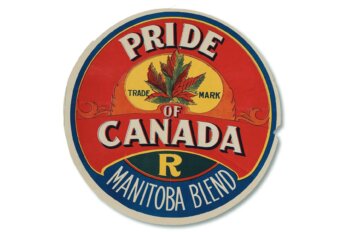Self-described “rezzed out hillbilly” Mi’gmaq director Jeff Barnaby’s latest film, Blood Quantum, is a searing indictment of colonialism—and also a zombie flick, full of squelchy gore, chainsaws, machetes, and buckets of blood. As a massive wimp, I’ll admit I watched through my fingers at times, eyes pressed closed when scenes got particularly wet.
The movie (which premiered at the Toronto International Film Festival last year, is now available to stream, and will soon be released on disc) begins by splashing the text of a rather violent proclamation, identified as an “ancient settler proverb,” across the screen:
Take heed to thyself, that thou make no treaty with the inhabitants of the land whither thou goest lest it be cause of ruin among you. Break down their altars, smash their sacred stones and burn down their groves.
I was curious what this was from, and a quick search revealed it was a version of a passage (specifically Exodus 34:12–16) from the Old Testament—a fairly important settler text, I suppose. It was a clever reversal of observer and subject roles: in most films about Indigenous peoples, the gaze of the white anthropologist/colonizer is foregrounded, but here the lens is turned outward; something supposedly familiar, now seen from the opposite perspective, is made strange and unsettling.
Most zombie movies are set in the present or near future. This helps with the suspension of disbelief, which is strained when a zombie apocalypse happens in a past we already know. One of the points Blood Quantum makes, though, is that white settlers might not actually know that past as well as they think they do, and so, rather than setting this film in the near future, Barnaby set it in 1981. That was the year of two major salmon raids by the Quebec Provincial Police on the Listuguj reserve (formally known as Restigouche)—events that were documented by Abenaki director Alanis Obomsawin in her film Incident at Restigouche. In the first raid, approximately 500 police officers, fisheries officers, and game wardens descended on the small community, beating and arresting Mi’gmaq and seizing their nets. Listuguj Mi’gmaq mobilized and erected barricades, preventing outside access to the community; another raid followed just over a week later. It was an astonishing show of state violence that most Canadians are completely ignorant of.
The raids were intended to stop Mi’gmaq from asserting their inherent rights over their fishery and had a profound impact on Mi’gmaq of Listuguj, including Barnaby. But the salmon raids themselves are not in his film; here, it’s the zombie apocalypse that poses the threat from outside. In Blood Quantum, the barricades on the fictional Red Crow reserve are meant to keep out the white people who have become zombies, and everything pulled from the river, including salmon, is “bad meat.” As an allegory, it may seem a little on the nose: white people attacking and literally trying to consume everyone around them, depriving Mi’gmaq of one of their most important food sources—until you remember that most Canadians don’t have the education they need to put the clues together.
Take the name of the film, a play on the colonially imposed measurement of a person’s Indian blood, like a dog pedigree for people. In the context of the film’s zombie plague, only Indigenous peoples are immune, and blood is spilled in epic quantities. Barnaby found that, for non-Indigenous audiences, the name was opaque. Personally, I thought it was hilarious, but I’ve had to explain “the joke” enough times that it has stopped being funny.
Speaking to Barnaby on the phone was a lot like chatting with a friend over a cup of Red Rose or a pint of beer. He’d been doing interviews for a couple of days straight, but he still had the energy for a two-hour conversation about his work and the ups and downs of being an Indigenous director in Canada.
He had chosen not to explain the title Blood Quantum in the film itself, but he admitted he sometimes questioned that choice after being asked repeatedly by non-Indigenous people what it meant. Expressing his frustration, he told me, “I wanted to yell, ‘Why don’t you know this already, these are your ideas! Why can’t you learn about your own history?’
“As an Indigenous filmmaker or artist, you have to put in that extra effort, give people reading materials about their own fucking history, the stuff they should already know, [for them] to understand where you’re coming from. It’s a little bigger than just ‘white people are evil.’ Canadians need to meet us halfway and educate themselves.”
It does seem like an impossible onus on Indigenous storytellers. How do you convey, in ninety minutes, all of the context and information that the audience should already know? As Barnaby aptly pointed out, ninety days wouldn’t even be enough time to get Canadians caught up on their own history in relation to Indigenous peoples, never mind trying to get them to understand all the historic and contemporary nuances embedded in Indigenous-created media.
The obstacles don’t stop there. Barnaby insisted the film be shot in his home community of Listuguj, as well as in Kahnawake, a Mohawk reserve. He says that non-Indigenous people don’t always understand the importance of place, and that, in the film industry, there can be barriers to filming in one’s home territory.
“These things matter to us,” he explained, “land, language, culture. Getting it right is important.” And why shouldn’t Indigenous people see their own lands and realities on the big screen? Why should we have to accept substitutes, alien landscapes far from our actual territories?
This issue isn’t just authenticity, it’s very much about accountability. Barnaby is a rez-bred filmmaker—which he discusses with pride—bringing a very underrepresented perspective to Indigenous films. His focus is on contemporary experiences of people on reserve, even if his stories are sometimes set in the near future or past. In Blood Quantum, those swooping, twirling opening shots of Campbellton (called Hollarbaster in the movie), the non-Indigenous town across the Restigouche River from Listuguj (Red Crow), and the shots of the J. C. Van Horne bridge and St. Anne’s church—these are all recognizable, iconic images for Listuguj Mi’gmaq.
“Indigenous filmmakers have to approach their work from three directions,” Barnaby told me. “One, the film has to be culturally relevant, and maybe that’s not going to sell; two it needs to be technically proficient, like the zombie kills need to be great; and, third, you need a good story that’s interesting and relevant. But all of this is mitigated by an audience that is probably not going to be on the same page as you, producers that don’t know where you’re coming from, and that silver bullet that often kills a lot of these productions: lack of money.”
Fear of the apocalypse informs so much current mainstream speculative fiction, but what is the apocalypse, really? Zombies, pandemics, environmental collapse, alien invasion—the particulars aren’t that important. At their roots, visions of apocalypse are characterized by the breakdown of social and political systems, extreme changes to the environment, and widespread violence. Essentially the end of the world as we know it.
For Indigenous peoples, this is old news—literally “been there, done that.” Apocalypse exists not only in the future; it is a series of fractures we’ve already experienced. It should be no surprise, then, that today’s Indigenous storytellers invoke apocalypse often and with familiarity: Marie-Hélène Cousineau and Madeline Ivalu in their 2008 drama, Before Tomorrow; Danis Goulet in her short film Wakening; and Waubgeshig Rice in his novel, Moon of the Crusted Snow. After all, we are survivors, battle scarred to be sure, but gloriously, defiantly alive in spite of our ongoing losses. This helps to explain why, at their heart, Indigenous tales of apocalypse are messages of hope, no matter how dark the subject.
It is within this context that Barnaby creates films that lay bare the often disturbing postapocalyptic world Indigenous peoples have inhabited since contact. Throughout his cinematic works over fifteen years, Barnaby repeatedly tackles the legacy of ongoing colonialism and intergenerational trauma as experienced by his Indigenous (specifically Mi’gmaq) characters, even exploring potential dystopian futures as rife with systemic racism as the present. Like in Blood Quantum, a consistent theme in his short films, From Cherry English, The Colony, and File Under Miscellaneous, is the horror-from-within that results from this history of colonial violence. Self-destructive impulses, rooted in internalized self-hatred, that manifest in murder, suicide, betrayal. These are not noble savages but complex characters, sublime, flawed, even haunted—some literally, such as Kawennáhere Devery Jacobs’s character, Aila, in Barnaby’s first feature, Rhymes for Young Ghouls.
It would be easy to dismiss Barnaby’s characters as the agents of their own downfalls, attributing failures and triumphs to individual choices, ignoring the wider context of historic and ongoing theft of land and resources, systemic racism, and child removals. This is a barrier to all Indigenous storytelling, fiction and nonfiction alike. An audience that is ignorant of Canadian history—and Barnaby is emphatic that this is Canadian history, not Indigenous history—may be missing the forest because of the hordes of zombies rampaging through the trees.
I asked Barnaby if I could read him a poem by Cree author Billy-Ray Belcourt, from his latest book, NDN Coping Mechanisms. The poem, on page seventeen, is called “Cree Girl Blows up the Necropolis of Ottawa,” and it starts with a summary of Barnaby’s last film, Rhymes For Young Ghouls. The poem goes on to describe the possibility of movie-making, of existing, where Indigenous people document and chart our own worlds, outside of the constant violence and history of white supremacist settler colonialism. It imagines us transcending the narrative we’ve been allowed, maybe even rejecting the kinds of films that are Barnaby’s legacy. Except, after speaking with Barnaby for over an hour, I got the sense that Belcourt’s vision fits well into the kind of potentialities the Mi’gmaq director is reaching for.
When I finished, there was surprised silence on the line for a moment, then, “I think that’s a good idea for a movie!
“I’m so insulated, it’s weird to see how that film has affected people, to the point where they are writing poetry about it, and it’s not like [Belcourt] is a small name! I don’t think of myself as famous or known, I don’t interact with a lot of people, I leave the house every five years to make a movie. I’m not pondering what my effect on the world is, I have to let it go at one point.”
Barnaby’s films are often dark and disturbing—after all, he dabbles in dystopia—but I was interested to know if he had a vision of utopia too. What if we could have it all? What would that look like for Indigenous film and art? What could it mean for us in the day-to-day?
“I don’t think I’ll ever experience an all-Native crew in my lifetime, but I hope that someone will,” he mused. His exhaustion with navigating this work in a mostly non-Indigenous film industry was a constant theme during our conversation, and I get it. It’s hard enough as an artist, trying to bring your vision to life, without having to always stop and explain things that other Indigenous people would just know intuitively, like why filming in Listuguj was essential, or why living in a city far from home can be demoralizing at times.
Yet it was Barnaby’s wider vision of an Indigenous utopia that surprised me.
“For me, it’s integration. Spaces where Native people can learn their individual languages that are integrated with the culture at large. So, instead of my son going to school and having French forced on him, having the opportunity to learn Mi’gmaq. And that’s not science fiction! That’s not fucking flying cars and oh look we’ve cured cancer, it’s not even that.
“A utopia for us is just having basic, fundamental, equal rights. Like a Native person, if they need a flu shot, they get one! Or if they need a clean glass of water, they can turn on the tap. Just basic, simple shit. The opportunity to do things on an equal footing.”
It doesn’t seem like much to ask for, Canada, and I promise we do not need an apocalypse or a zombie invasion to teach us the value of working together and making things better. So how about we reach for a little . . . utopia now?




